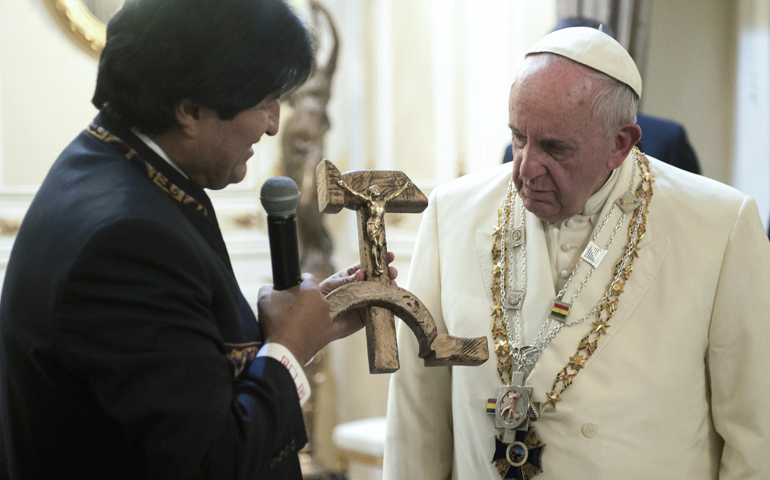
Bolivian President Evo Morales presents a gift of a wooden hammer and sickle -- the symbol of communism -- with a figure of a crucified Christ to Pope Francis at the government palace in La Paz, Bolivia, on Thursday. (CNS/L'Osservatore Romano )
When Bolivian President Evo Morales gave Pope Francis a crucifix atop a hammer and sickle, eyebrows were raised, including the pope's.
But, as Morales explained, the cross was created by Jesuit Fr. Luis Espinal, who was assassinated in 1980 after being active in the country's pro-democracy movement.
The pope and president were surrounded with clicking cameras Wednesday during the gift presentation in the government palace in La Paz.
A Vatican television camera was present but, as Jesuit Fr. Federico Lombardi, Vatican spokesman, told reporters, the audio is almost impossible understand.
At least one media outlet reported the pope saying, "That's not right," ("No esta bien eso") but several others said the pope, who was speaking Spanish, responded, "I didn't know that" ("Eso no lo sabia") when Morales explained the cross was based on a design by Espinal.
Lombardi, who said neither he nor the Jesuit pope had ever seen or heard of Espinal's crucifix, said he believes it is much more likely that the pope admitted to not knowing its origin than to saying it was wrong.
After discussing the cross with several Jesuits on Thursday, Lombardi said that Espinal, who "was an artist, very creative," made the crucifix as an expression of his belief in the need for dialogue involving all Bolivians at a time of great political tension and upheaval.
For Espinal, "it was not ideological," Lombardi said; he was not giving "a Marxist interpretation of the faith."
How other people interpret the piece or use it today is another question, the spokesman said.
"Certainly, though, it will not be put in a church," he said.
The crucifix, he added, was "an expression of what Espinal was living" at the time he made it.
Asked his personal reaction to the piece, Lombardi said he tried to understand the origin of the piece and what Espinal intended when he made it.